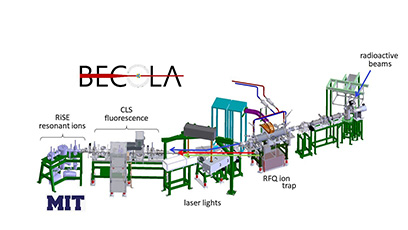
Adjunct Professor of Physics
Joined the laboratory in 2004
Education and training
- MS, Physics, Osaka University, Japan 1996
- PhD, Physics, Osaka University, Japan 1999
Research focus
- Experimental nuclear physics
Contact information
Links
Research
What are the most prominent features of a nucleus? Arguably, its size or shape is one of them. My current research interest is to measure the size, shape, or the charge radius of radioactive nuclides that occur near the limit of nuclear existence. The size of a radioactive nucleus tells us how nucleons are distributed in its interior, and it is essential for understanding the driving forces for the structure and how it differs from stable nuclei surrounding us.
Because nuclei are very dense, their size is governed by the nuclear equation of state (EoS), which also determines the nature of another dense nuclear matter, neutron stars. However, neither the form of EoS nor the structure of neutron stars is well known as of yet. Here our measurements of nuclear size in turn can help determine parameters of EoS, connecting our terrestrial measurement of a tiny object to a better understanding of astronomical neutron stars.

Biography
I spent my childhood in a small town in Kyoto, a historical city in Japan. There are a lot of shrines, temples, and historic spots in my hometown, where I often visited for a walk. After graduating high school in Kyoto, I went to Osaka University for my graduate studies. I obtained a Doctor of Science in nuclear physics in 1999 for fundamental symmetries test (the G-parity violation via induced currents in the weak nucleon current). I held two postdoc positions in Osaka and TRIUMF in Canada, where I slowly changed my interest toward nuclear structure. I arrived at Michigan State University in 2004. I am an experimentalist and like to see responses of nature to understand what is happening. My current interest is to measure the size/shape of radioactive nuclei, especially at the existing limit of nuclides using laser-assisted precision techniques. This leads to understandings of underlying nuclear forces as well as the dense nuclear matter, namely neutron stars.
How students can contribute as part of my research team
A student in my group is typically responsible for one development project and one laser spectroscopy experiment where the student runs experiments, analyzes data, interprets results, and writes papers. Students will have training opportunities to gain hands-on experience in running laser spectroscopy experiments for nuclear structure studies. We currently use the laser-resonant fluorescence and laser-resonant ionization techniques. We often run offline laser spectroscopy experiments with stable beams produced locally, in addition to online experiments with radioactive beams for testing and commissioning, as well as for science. The experimental system includes but is not limited to the operation of various laser systems (CW and pulsed), the ion-beam production from offline ion sources, the ion-beam transport, and the data acquisition system.
Scientific publications
- Nuclear charge radii of silicon isotopes, Kristian König et al., Phys. Rev. Lett. 132, 162502 (2024)
- Surprising Charge-Radius Kink in the Sc Isotopes at N = 20, Kristian König et al., Phys. Rev. Lett. 131, 102501 (2023)

